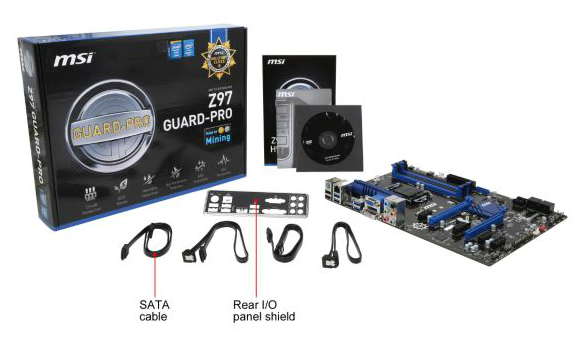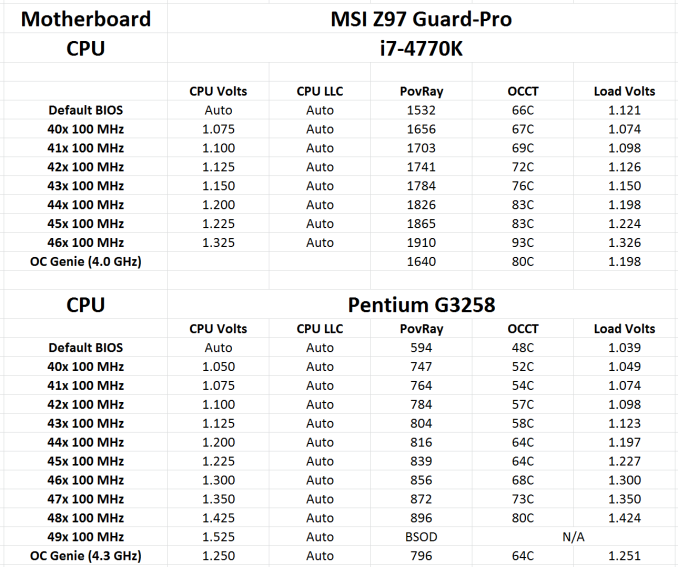MSI Z97 Guard-Pro Review: Entry Level Z97 at $110
by Ian Cutress on August 20, 2014 6:00 AM EST- Posted in
- Motherboards
- Intel
- MSI
- Z97
MSI Z97 Guard-Pro In The Box
Like the other low cost motherboards we have seen, especially in our $140 mini-ITX roundup, bundles for cost-conscious products are relatively thin. When there are less features on the board, there is less of an opportunity to add extras, but also there tends to be minimal branding for other bundled items, such as the door hanger in MSI’s gaming range.
In the MSI Z97 Guard-Pro we get the following:
Driver Disk
Manual
Rear IO Shield
Four SATA Cables
Four SATA cables are relatively unexpected, I would have thought two but this is a nice surprise.
Many thanks to...
We must thank the following companies for kindly providing hardware for our test bed:
Thank you to OCZ for providing us with PSUs and SSDs.
Thank you to G.Skill for providing us with memory.
Thank you to Corsair for providing us with an AX1200i PSU and a Corsair H80i CLC.
Thank you to MSI for providing us with the NVIDIA GTX 770 Lightning GPUs.
Thank you to Rosewill for providing us with PSUs and RK-9100 keyboards.
Thank you to ASRock for providing us with some IO testing kit.
Test Setup
| Test Setup | |
| Processor |
Intel Core i7-4770K ES 4 Cores, 8 Threads, 3.5 GHz (3.9 GHz Turbo) |
| Motherboard | MSI Z97 Guard-Pro |
| Cooling |
Corsair H80i Thermalright TRUE Copper |
| Power Supply |
OCZ 1250W Gold ZX Series Corsair AX1200i Platinum PSU |
| Memory | G.Skill RipjawsZ 4x4 GB DDR3-1600 9-11-9 Kit |
| Memory Settings | 1600 9-11-9-27 1T tRFC 240 |
| Video Cards | MSI GTX 770 Lightning 2GB (1150/1202 Boost) |
| Video Drivers | NVIDIA Drivers 337 |
| Hard Drive | OCZ Vertex 3 256GB |
| Optical Drive | LG GH22NS50 |
| Case | Open Test Bed |
| Operating System | Windows 7 64-bit SP1 |
| USB 2/3 Testing | OCZ Vertex 3 240GB with SATA->USB Adaptor |
MSI Z97 Guard-Pro Overclocking
Experience with MSI Z97 Guard-Pro
One argument for Intel’s chipset segregation (Z97, H97, H81, B85 etc.) is that boards not oriented towards overclocking can save some money and buy a cheaper chipset. Because MSI went with the Z97 here, overclocking should be one of the main features. When MSI and I discussed the motherboard, they promoted it as a nice cheaper board for overclocking the Pentium G3258, and to push the point they provided a good G3258 to let me test the legs of the system.
Our G3258 sample from MSI went to 4.8 GHz at 1.425 volts, giving an 80ºC peak temperature, which is rather impressive and indicates that no matter how good/bad your CPU might be the Z97 Guard-Pro should be a low cost option for air/water overclocking. MSI’s auto overclocking (via OC Genie) pushed the CPU from 3.2 GHz to 4.3 GHz, giving a healthy +1100 MHz with a single option change.
We also went in with our regular i7-4770K CPU for overclocking, and it hit 4.6 GHz at 93C. This temperature at 4.6 GHz is a little high compared to our best results, but in line with some of our other Z97 motherboards.
It is worth noting one issue we had during testing: if the CPU voltage was not sufficient, it would be a pain to get into the BIOS in order to add additional voltage as the system would hang. As a result, this meant more often than not I would need to reset the BIOS and put in all my options again. This stems from the fact that the board implements the CPU frequency and voltage during POST, rather than right at the end like some other motherboards.
Methodology
Our standard overclocking methodology is as follows. We select the automatic overclock options and test for stability with PovRay and OCCT to simulate high-end workloads. These stability tests aim to catch any immediate causes for memory or CPU errors.
For manual overclocks, based on the information gathered from previous testing, starts off at a nominal voltage and CPU multiplier, and the multiplier is increased until the stability tests are failed. The CPU voltage is increased gradually until the stability tests are passed, and the process repeated until the motherboard reduces the multiplier automatically (due to safety protocol) or the CPU temperature reaches a stupidly high level (100ºC+). Our test bed is not in a case, which should push overclocks higher with fresher (cooler) air.
Overclock Results












41 Comments
View All Comments
Samus - Thursday, August 21, 2014 - link
Definitely agree about the Core 2's. Anything pre-Bloomfield is showing its age. But there is a subtle but noticeable difference between a Pentium Haswell and a Core i3 Haswell when using Windows 8/Office 2013, especially in Outlook and Access (programs that deal with large data files)Flunk - Wednesday, August 20, 2014 - link
I think it would match better with a i5 4670k, you're better off buying one of the few H-series boards that support overclocking the Pentium AE and saving the rest. If you're paying more for your board than your CPU you have a problem.Computer Bottleneck - Wednesday, August 20, 2014 - link
I'm glad Ian reviewed this board. It is very pertinent considering it is a board that has been bundled with Pentium G3258.Just less than a week ago the Pentium G3258 was on sale with the MSI Z97 Guard Pro for $110 AR ---> http://forums.anandtech.com/showthread.php?t=23954...
We don't find these kind of deals with the i3 or other Pentiums or Celerons.
Gigaplex - Wednesday, August 20, 2014 - link
It's a bit late to get into GPU bitcoin mining...Shadowmaster625 - Wednesday, August 20, 2014 - link
Ironically, I just got this board in last night, as part of a TD $100 G3258 combo. My G3258 will no go past 4.4GHz @ 1.299V. And the temps hit 92C under full load so upping the voltage isnt really an option. Even though these temps are high, I'm just going to leave it because during my suite of real world tests, the temps stayed below 70C.My main issue with the board is that my ethernet cuts out whenever I plug in any USB device. I have to unplug my LAN and then plug it back in or else it wont work. I tried plugging in a thumb drive as gently as I possibly could and it still caused the LAN to die.
Another annoying issue is that every time I move my SSD to a different SATA port, it makes the board think the overclocking failed, so I have to go back into the BIOS each time and turn it back on.
hojnikb - Wednesday, August 20, 2014 - link
Looks like a defected mobo, if you ask me.kwrzesien - Wednesday, August 20, 2014 - link
As far as the M.2 specs go, straight from the MSI manual:Intel Z97/ H97 Express Chipset
6x SATA 6Gb/s ports (SATA1~6)
1x M.2 port*
M.2 port supports M.2 SATA 6Gb/s module
M.2 port supports M.2 PCIe module up to 10Gb/s speed**
M.2 port supports 4.2cm/ 6cm/ 8cm length module
Supports RAID 0, RAID1, RAID 5 and RAID 10***
Supports Intel Smart Response Technology, Intel® Rapid Start
Technology and Intel Smart Connect Technology****
* The SATA5 and SATA6 ports will be unavailable when installing a module in the M.2 port.
** M.2 PCIe interface only supports UEFI option ROM, NOT support legacy option ROM.
*** M.2 PCIe interface does not support RAID 0, RAID1, RAID 5 and RAID 10.
**** Supports Intel Core processors on Windows 7 and Windows 8/ 8.1
So I don't see anything in the manual about the M.2 disabling any of the PCIe slots, either for SATA or PCIe type M.2 drives - it appears to use the SATA 5 & 6 ports either way. Anyway this is a PCIe 2.0 x2 10MB/s type connection, not x4 and not PCIe 3.0. Still would be very fast with the Plextor PCIe M.2 drives (which oddly cost less than the slower Micron SATA M2. drives): http://www.newegg.com/Product/Product.aspx?Item=N8... It appears that booting is supported natively.
anthill - Wednesday, August 20, 2014 - link
Anandtech should do an article discussing minimum fps. Looking at the bioshock numbers the difference between the best and worst motherboard is 13fps. Even the top board dips below the 30fps threshold that not even a g-sync monitor can help you with. BF4 isn't as significant but one still would be at a ~5fps disadvantage versus picking the top performing motherboards.Is this driver related? Can it be improved upon by opting for faster ram, 2133 vs 1600?
I feel it's a topic they could look into. Especially with VR coming soon I have read a gamer would need to hit a locked 90hz to feel a sense of "presence". These minimum fps benchmarks could become an issue going forward if one wants to hit the target fps needed.
StrangerGuy - Wednesday, August 20, 2014 - link
Why is anybody still running CPU performance benchmarks on mobo reviews in 2014 is beyond me. We would much rather see LPC latency, LAN/USB throughput, audio quality testing etc.lorribot - Wednesday, August 20, 2014 - link
Why is it always assumed that enthusiasts have unlimited funds? Most are probably like me, when it come to replacing the core of our system it is invariably on a restricted budget, not for us a $200 mobo and a $200 CPU. Anything that the mobo manufacturers can do to allow you to upsec the CPU to a K series is very welcome. I really don't care that it is Realtek as Intel will not really make that much difference over my poor adsl internet connection and I can't afford a speaker system that will show the difference between Realtek and Creative or anyone else's sound chips.All I want is a good strong, stable basic mobo that will allow overclocking for the minimum cost, this board gets close to this ideal.